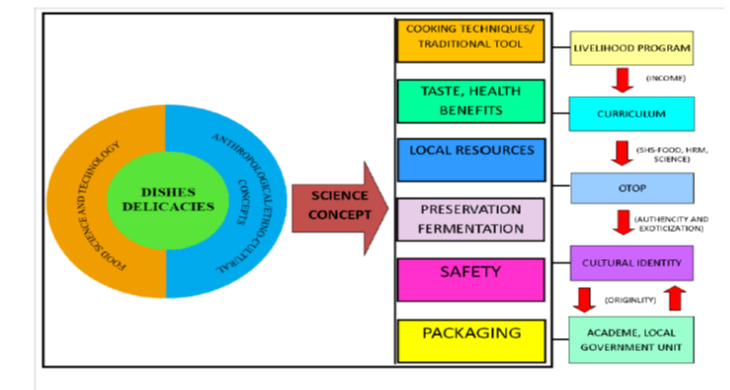


Indian Journal of Science and Technology
Year: 2021, Volume: 14, Issue: 3, Pages: 197-207
Original Article
Fernan Peniero Tupas1,2*, Louiege B Banas3
1Faculty, Department of Biology, Northern Iloilo Polytechnic State College, Estancia, Iloilo, Philippines
2International Research Fellow, Japan Society for the Promotion of Science, Tokyo, Japan,
and Laboratory of Biotechnology and Bioengineering, Hokkaido University of Education, Hakodate, Hokkaido, Japan
3Faculty, Hospitality Management Department, Northern Iloilo Polytechnic State College, Ajuy, Iloilo, Philippines
*Corresponding Author
Email: [email protected]
Received Date:06 August 2021, Accepted Date:24 September 2021, Published Date:25 January 2021
Purpose: The main objective of this research is to science concepts in local dishes and delicacies in 34 barangays in the Municipality of Ajuy, Iloilo, Philippines. Furthermore, to value its contribution to LGU and academe. Methods: This qualitative research specifically used ethnoscience through interviews, focus group discussion (FGD), and observation. But because of the pandemic, automated micro-targeting using Facebook (FB) was also used. All the responses of the informants were coded, analyzed, triangulated, and themed. Findings/application: Out of 34 barangays in the Municipality of Ajuy, 6 have local dishes, and 11 for local delicacies were recorded. However, most of these foods were not local from Ajuy but were adapted from neighboring places and islands. All the identified food, “barikutsa” (sugar and coconut milk candy) for delicacy, and “Patotin filled with Valenciana” for dish stood out the most due to no preservatives and processed ingredients. The local dishes and delicacies reflect the unique Philippine traditions—the abundance of local resources from land and sea. Informants identified nine science concepts: cooking techniques, traditional tools, taste, health benefits, local resources, preservation, fermentation, safety, and environmental friendly packaging.These local dishes and delicacies can be critical to the academe and local government units (LGU) such as livelihood programs, curriculum, OTOP, and cultural identity. As a result, the study suggested to different stakeholders in the municipality to work together to enhance the local cuisines. Also, it introduced “Patotin filled with Valenciana” and “barikutsa” in any municipal activities and encouraged educators to integrate into the curriculum. Ajuy’s best and unique cookeries must be enhanced and preserved to boost tourism, and finally,improved way of living.
Keywords: Dishes and delicacies; local resources; science concepts; municipality of Ajuy
© 2021 Tupas & Banas.This is an open access article distributed under the terms of the Creative Commons Attribution License, which permits unrestricted use, distribution, and reproduction in any medium, provided the original author and source are credited. Published By Indian Society for Education and Environment (iSee)
Subscribe now for latest articles and news.